WALKING THROUGH A WORK OF ART – MONET’S GARDENS AT GIVERNY
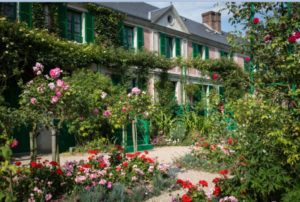
We have often been asked about visiting Monet’s gardens at Giverny. How difficult is it to get there independently, or is it best to take a tour from Paris? Is it really worth it, or has it become a victim of tourist hype? Are the hordes of visitors a turn-off? Is it possible for those who want to experience the atmosphere and tranquility of a beautiful garden to still enjoy a visit, given its enormous popularity?

Giverny is probably the most famous garden in France. For many, the best loved and revered Impressionist painter among so many would probably be Claude Monet, who created this garden at his home in Giverny, a quiet backwater in Normandy. He lived there until his death in 1926, the gardens and water features giving him his greatest artistic inspiration. Since his home opened to the public in September 1980, it has become one of the most popular tourist destinations in the country. Attracting over 500,000 visitors each year, it’s the most popular attraction in Normandy, after Mont Saint Michel.
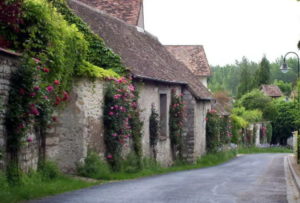
Giverny lies on the bank of the river Seine in Normandy, about 6 kms from the town of Vernon. Were it not for the arrival of Monet in 1883, the village would likely have remained unknown to the wider world. It was quite by chance that Monet discovered Giverny, having seen it from a train window as it made an unscheduled stop. Enchanted by what he saw, he alighted—he was sure that he would find interesting things to paint there. He rented a modest house situated near the main road between the towns of Vernon and Gasny at Giverny. There was a barn that doubled as a painting studio, orchards, a small garden, and the house was close enough to the local schools for the children to attend.
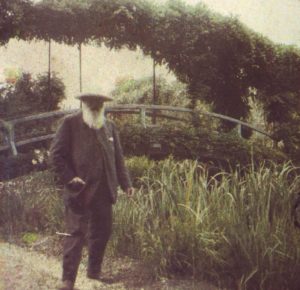
As the years passed, he grew attached to the village, the countryside from which he took inspiration and the garden which was to become an all-consuming passion. In 1890 Monet purchased the house and built a greenhouse and a second studio, a spacious building well-lit with skylights. He lived in Giverny for the rest of his life.
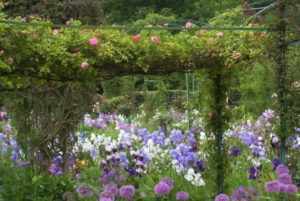
Monet’s fortunes began to change for the better as his art dealer, Durant-Ruel, had increasing success in selling his paintings, enabling the gardens to be enlarged and improved. In the early years, the priority was for the garden to support the family, but as his finances improved, Monet was able to turn the vegetable plots into flower gardens.

The Giverny gardens became Monet’s greatest source of inspiration for over 40 years. He was a keen and knowledgeable gardener himself, and wrote detailed daily instructions to his gardener. Monet drew up precise designs and layouts for plantings, and kept invoices for his floral purchases as well as his growing collection of botanical reference books.
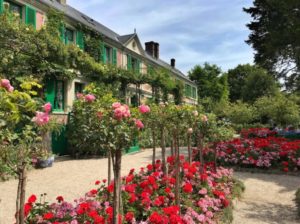
As his wealth grew, Monet’s garden evolved. He remained its designer, even after he hired seven gardeners. The flower gardens cover about a hectare, and are laid out in colour-themed long beds and borders with walkways between them, as well as some large areas of grass and trees. There are literally thousands of flowers in these gardens including masses of tulips, irises, oriental poppies, and peonies—all with wonderful colours that provided constant inspiration to the artist.
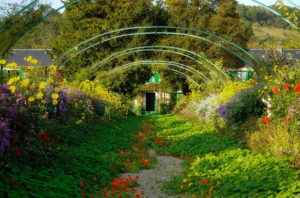
Careful management allows visitors to walk up some alleys but not others, which means that despite the huge numbers of people visiting, it is still possible to see much of the garden without people blocking views and making photography impossible. Studies of Monet’s paintings and research into the book written by one of Monet’s sons have all contributed to the authentic plantings of the gardens these days to reflect as much as possible those that Monet liked to grow.
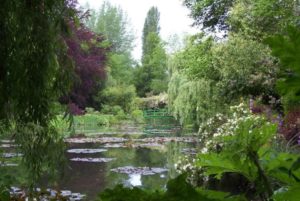
After a few years of living at Giverny, Monet purchased additional land that had a water meadow, across the road and railway line from his garden. He planted white water lilies local to France along with imported cultivars from South America and Egypt, resulting in a range of colours including yellow, blue, and white lilies that turned pink with age. In 1902, he increased the size of this garden by nearly 4,000 sq. metres; the pond was enlarged in 1901 and again in 1910 with easels installed all around to allow different perspectives to be captured.

These works weren’t achieved without a long dispute with his local council and his neighbours. The problems arose when in 1893 he first purchased the additional parcel of land and set about planning the construction of a large pond. He wanted to dig a channel from the Ru—a stream running into the Epte, which is itself a tributary of the Seine—to feed his pond and to build two wooden bridges, one across the diverted stream and the other across the pond itself. His motivation for this project, aside from his fondness for horticulture, was “for the pleasure of the eye and also for motifs to paint.” In March he applied to the local council for permission. Engineers sent out to inspect the site raised a number of objections, and Monet gave up in a huff.
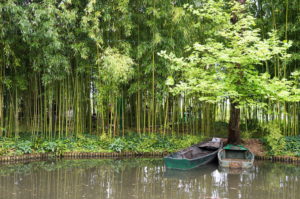
Sometime afterwards, he decided to apply again, but this time the objectors were his neighbours, with whom he had always had difficult dealings. They were concerned that the introduced waterlilies and other exotic water plants would invade the river downstream and choke the irrigation canals. They demanded that these plants be uprooted and removed at once, but Monet dismissed their fears and ignored their demands. The lilies were all left in place, where they remain to this day.
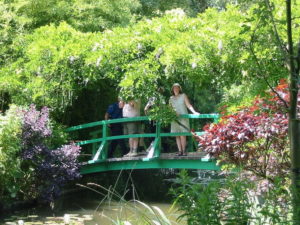
In July Monet wrote a withering letter to the district commissioner concerning his plans for the water gardens and the bridges, and ten days later, he received permission to proceed. Work started immediately, and by October the now-famous Japanese-inspired bridge over the lily pond had been built, in spite of the continuing protests of his neighbours.
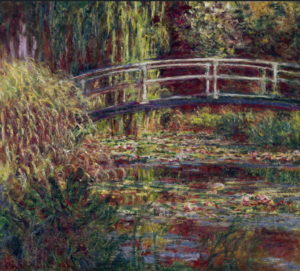
In 1899 the bridge itself was the subject of 12 different paintings, each portraying the bridge in different light and time of day, which were exhibited by Durant-Ruel’s gallery in 1900. More paintings featuring the bridge followed, the last being painted between 1920 and 1922 using a fiery palette of rusts, maroons, and oranges, unique within Monet’s body of work.
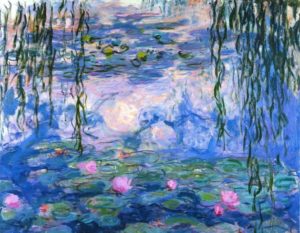
Claude Monet began painting his Water Lilies, or Nymphéas, series in 1899, once the plants had matured, providing an infinity of motifs to be observed from different viewpoints, and with a constantly changing play of light and reflections on the water’s surface. The Nymphéas series comprises approx. 250 paintings, and were the main focus of his artistic output during the last 30 years of his life. “One instant, one aspect of nature contains it all”, he once remarked, referring to his late works. Many of these were painted while he suffered from cataracts, yet regarded as some of his greatest achievements as an artist.

During WW1, after several years of relative inactivity because of ill health and grief over the death of his second wife, Alice, Monet embarked on a period of intense work. He built a larger studio and continued to improve his garden, and began a group of monumental paintings of water lilies. On 12 November 1918, the day after the Armistice, he wrote to his old friend, Georges Clemenceau, offering two of them to the State. “I am on the verge of finishing two decorative panels that I want to sign on Victory day, and am going to ask you to offer them to the State…It’s not much, but it is the only way I have of taking part in the victory.” However, Clemenceau persuaded him to offer the whole series. These are now to be found in the Orangerie in Paris, at the Place de la Concorde end of the Jardins des Tuileries.

It doesn’t matter how many times you see them, they are guaranteed to stop you in your tracks! Their enormous size and wonderful colouration make you feel as though you are immersed in the water lily ponds themselves. There are also magnificent collections of Monet’s works in Paris at the Musée d’Orsay and most especially, the Musée Marmottan Monet. Many art museums around the world have at least one Monet, but if you’ve only time for one, head to the Marmottan. To learn more, have a look at my blog from 2021: https://parisplusplus.com/paris/the-musee-marmottan-monet-a-little-known-gem-in-paris/
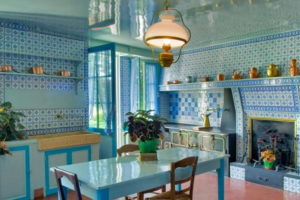
During his lifetime, Monet enlarged and adapted the original house to suit the needs of his family and his professional life. He enlarged it on both sides, and the house we see today is now 40m long, but still only 5m wide, in keeping with the original home. The two wings added by him can be discerned thanks to the size of the windows: the new ones are broader than the windows of the central part of the building. At one end Monet designed a large kitchen, suitable to prepare the meals of a ten person household that entertained a great deal. Over the kitchen, his four step-daughters had their bedrooms while his two sons and his two step-sons slept in the attic.
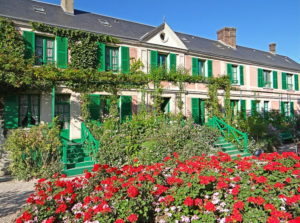
The pink colour of the exterior walls and the green shutters were chosen by Monet, a break away from the tradition of the times when shutters were traditionally painted grey. He also added a gallery to the front of the house, a pergola covered with climbing roses, and grew a virginia creeper on the façade: he wanted the house to blend with the garden.

The house has 3 entrances from the garden: the left leads to Monet’s apartment, the middle is the main entrance, and the right-hand one is for domestic use and leads to the kitchen.
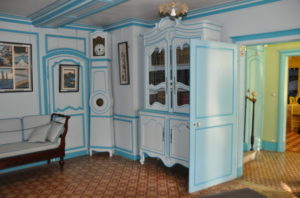
Monet, who loved colours, chose all the colours in the house. The blues of the sitting-room used for the walls as well as the furniture, harmonise with the Japanese woodblocks that Monet collected passionately for 50 years—he owned 231 of them, and he said they inspired him. He chose with an expert eye, and his prints are by the best Japanese artists, especially Hokusai, Hiroshige and Utamaro. Copies of some of his works add authenticity to the visitor’s experience of the house.
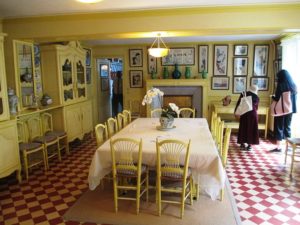
Perhaps the most dramatic room of the house is the dining room, painted in two tones of yellow. This vibrant colour enhances the blues of the dishes on display in the cabinets. All the furniture and objects throughout the house are the originals, giving an atmospheric authenticity to the home.
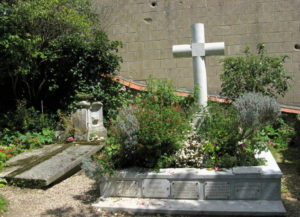
Claude Monet died of lung cancer on 05 December 1926 aged 86, and Michel, his only surviving son, inherited the property. However, Michel was not interested in living at Giverny, preferring instead to run safaris in Africa. Blanche Monet, Alice’s daughter, and widow of Monet’s son Jean, took over the house and garden, aided by the chief gardener. When Blanche died in 1947, the garden was almost abandoned, and nature inevitably took over.
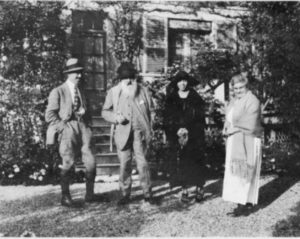
When Michel Monet died in 1966 in a car accident, and without an heir, he bequeathed the collection of his father’s works, as well as the house and garden to the Académie des Beaux-Arts. The Académie however, did not have the financial resources in those days to do little more than make necessary repairs to the roof of the house, and removed the paintings to add to the collection at the Musée Marmottan. In 1977, the Académie entrusted the rescue of Giverny to Gerald Van der Kemp, renowned for his restoration work on the Château de Versailles, and also an accomplished gardener and painter.

The Giverny house was in a pitiful state and desolation reigned supreme in the gardens, which were overgrown with brambles and weeds, many trees were dead, the greenhouses were mostly shattered wrecks, the stakes and trellises were all rusted, the water garden was stagnant with black water, while the Japanese bridge was rotten through. The budget allocated by the Académie des Beaux Arts and the local Conseil General de l’Eure was totally inadequate for the mammoth task of restoration.
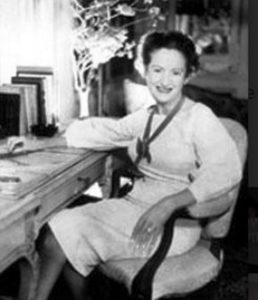
Van der Kemp and his wife Florence appealed to American donors through the Versailles Foundation-Giverny Inc. which was set up for the purpose. The first of these donors was the passionate flower-lover, Lila Acheson Wallace, owner of the Readers Digest and several of Monet’s paintings. Other donors quickly followed.
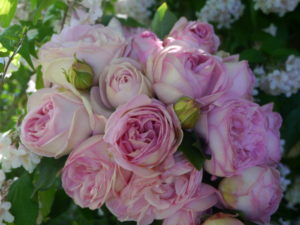
The Van der Kemps dedicated themselves to the restoration project, and by the 1970s, Americans had donated almost $7 million to the restoration fund. This was regarded as part of American diplomacy to France, since France lacked the American tradition of private giving as well as the tax concessions that encouraged it. Starting in 1969 under US President Richard Nixon, Americans could claim tax deductions for their contributions to charities, and this in turn aided the preservation of France’s architectural heritage.

The site was intensively restored during the years 1977-1980 and in 2011, an Englishman, James Priest, was appointed head gardener and put in charge of restoration and maintenance of the gardens. Priest said that he found a beautiful but time-worn “canvas” disfigured by some of the efforts of previous custodians, and set out to return Monet’s masterpiece to its original glory. He once said that “Visitors sometimes say that they feel that they have been standing inside a Monet painting. I couldn’t ask for a better compliment than that.” Nowadays, there is a passageway under the Gasny-Vernon road from the house and the gardens—the Clos Normand—to the water garden on the other side. In 1980, the Fondation Claude Monet was declared public and set up as a non-profit organisation. Their stated mission is that Giverny “must remain a living place.”
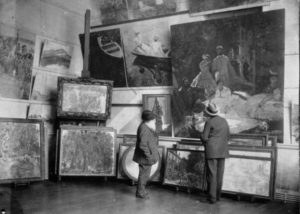
Getting to Giverny from Paris under your own steam is not difficult. Take the train from Gare St Lazare (the mainline station behind Au Printemps dept. store) to Vernon. The trip takes about 45 – 50mins., run about every 2 hrs. and a return ticket costs around € 18 p/p. Train seats aren’t booked, so you don’t have to commit to a specific return train when you purchase your tickets before you get there. As so many visitors want to go to Vernon, the ticket office people at Gare St Lazare are very used to dealing with non-French speakers. You’ll know you’re on the right platform by the number of people doing exactly what you’re doing! For convenience, you can get your ticket on your Smartphone. Shuttle buses for Giverny leave Vernon railway station 15 mins after the arrival of trains, and costs approx. €10 for the round trip. You can buy these tickets on board.
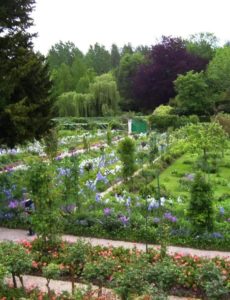
The house and gardens are open every day from April to November. Entry price into the house and the gardens: €11 p/p, self-guided, or you can book one of the independent guides either at the house or online. It’s strongly recommended to purchase entry tickets for the house and gardens online as visitor numbers are restricted every day. Leave plenty of time for your visit, as even though the gardens aren’t huge (about a hectare for the Clos Normand flower gardens), there is so much to see, and you’ll simply want to relax and not rush, especially when you arrive at the water garden.
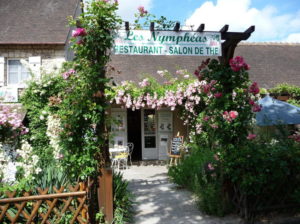
There’s a pleasant restaurant in Square Gerald et Florence Van der Kemp, just opposite the front of Monet’s house, called (what else?) ‘Les Nymphéas’ that offers full meals, or you can buy just a sandwich and drinks if you’re pressed for time, at the tearoom on the flowered terrace or the patio. As you’d expect, there is a gift and bookshop too, next to the restaurant, with a great range of Monet/Giverny themed merchandise. Many of the books are available in English.
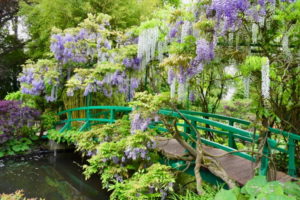
In answer to the original question, “is it worthwhile to go to Giverny”, the answer is most definitely yes! As you can see, it’s easy to do it on your own, and the advantage is that you do it at your own pace, taking all the time you want. However, if you still feel you’d prefer to take a tour, there are many such companies who do this, such as Viator. A 5 hr. half day tour will set you back around $75 – $100 p/p.
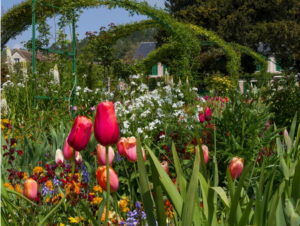
For keen gardeners who want to see specific plants at their best, there is an online calendar for what’s in bloom in the garden every month: https://giverny.org/gardens/fcm/calendar.htm There is also an online list of plants and flowers in the garden: https://giverny.org/gardens/fcm/fleurs/listflor.htm
“I must have flowers, always, and always.” Claude Monet
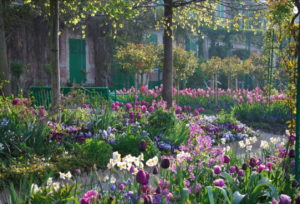


Thank you Cheryl. I have been twice BUT that’s not enough ! I hope to go again next year. Just breathtaking!
On the subject of other French gardens / towns, have you been to the Chedigny Roses Festival ?
Cheers, Lois
Hi Lois,
Glad you enjoyed the ‘Giverny’ blog. Agree that once or twice aren’t enough–we’ve been twice, many years apart, and not enough to take it all in. No, I don’t know about the Chedigny Roses Festival? Would love to know more–and where is it?? I love it when readers tell me about things/places I don’t know about!
Cheers, Cheryl
Hi Cheryl.
Thankyou so much for your posts I just love reading them .Nigel & I went to”Giverny in 2002 however Nigel is at a quite advanced stage of Semantic Dementia (young at 71yrs) and my chances of visiting are limited.
Love your posts please keep them coming
Regards
Sandy Dempster
Hi Sandy,
Lovely to hear from you. I’m so sorry to learn of Nigel’s condition. Yes, it makes life difficult and uncertain for you, so I’m glad the blog stories provide some cheer and hopefully, good memories. Stay well yourself, and do keep in touch.
Kind regards,
Cheryl